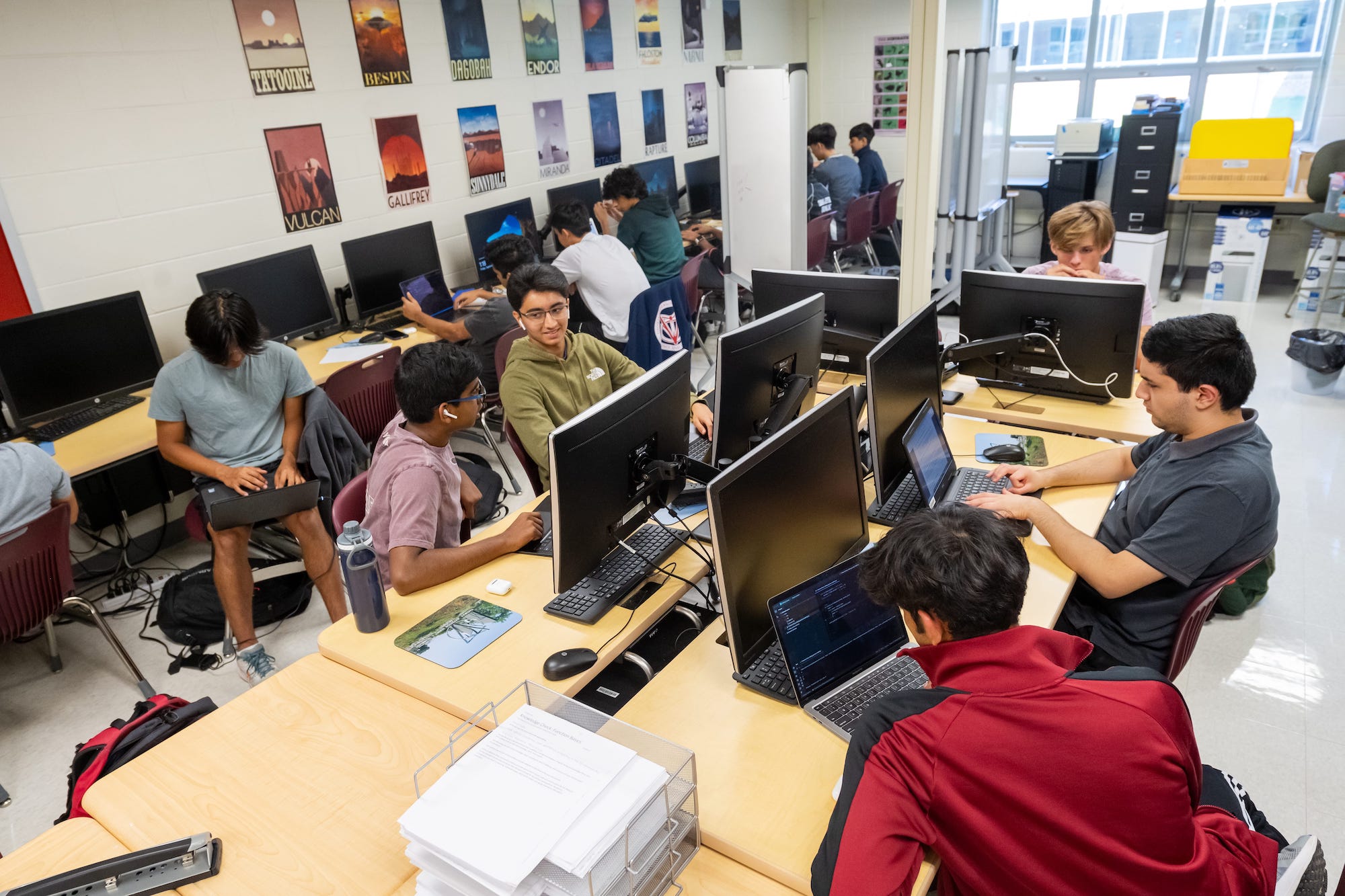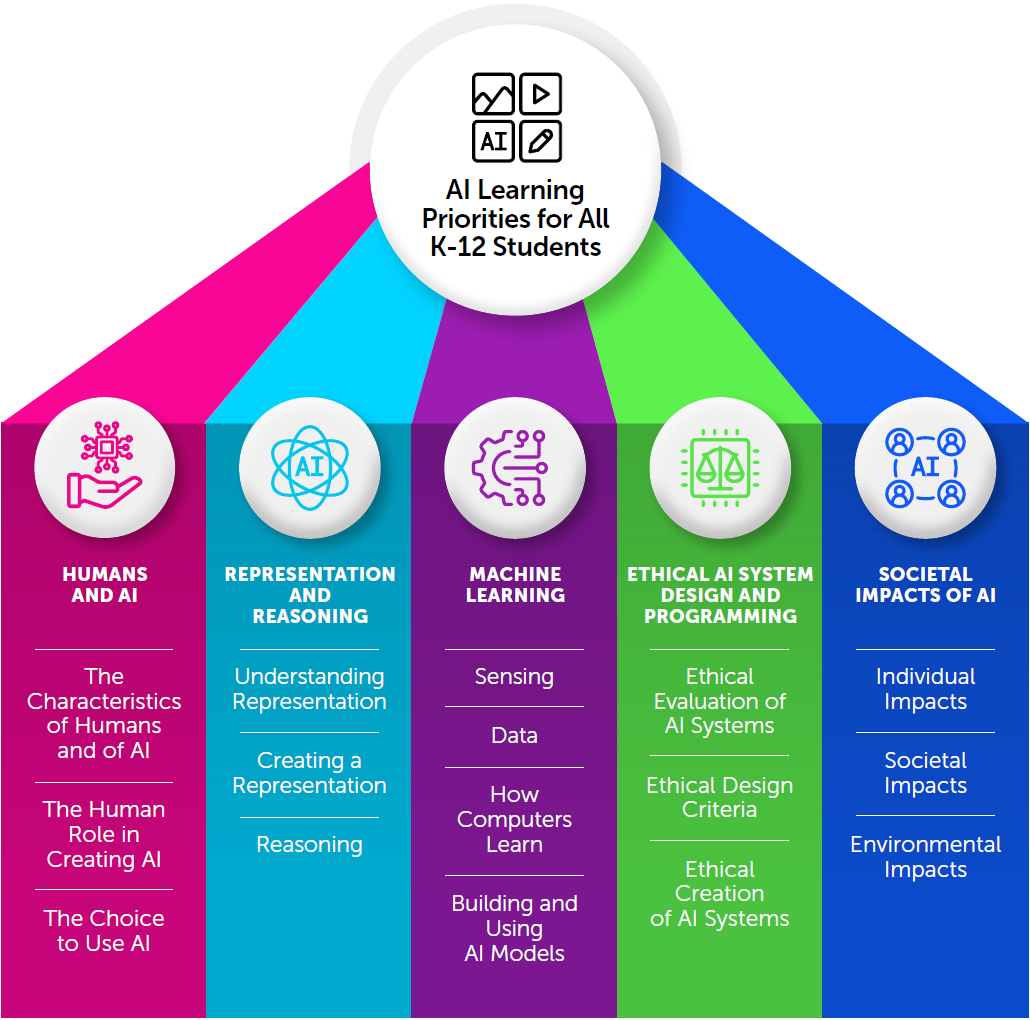AI Literacy for Florida
AI literacy is rapidly becoming a cornerstone of modern education, providing the foundational skills that individuals need to thrive in an increasingly digital world. According to Digital Promise, AI literacy includes “the knowledge and skills that enable humans to critically understand, evaluate, and use AI systems and tools to safely and ethically participate in an increasingly digital world.” For K–12 schools, this means ensuring that every stakeholder—from students and teachers to administrators, parents, community members, and IT support—can effectively and safely engage with AI. By prioritizing AI literacy, we uphold the community-focused values discussed throughout this document (such as ethical innovation, transparency, and safety) and prepare students for future workforce demands.
Learn what Task Force Leaders say about AI Literacy for Florida
What is AI Literacy?
AI literacy represents the technical knowledge, durable skills, and future-ready attitudes required to thrive in a world influenced by AI. It enables learners to engage, create with, manage, and design AI, while critically evaluating its benefits, risks, and ethical implications.
OECD (2025). Empowering learners for the age of AI: An AI literacy framework for primary and secondary education (Review draft). OECD. Paris.
This draft definition builds on existing definitions from the EU AI Act, OECD, UNESCO, and other organizations TeachAI AI Literacy Framework
Learning and Growing Together:
AI Activities for Your School
1. Virtual AI Family and Friends Night:
Host an online event where parents/guardians and students collaborate on creative AI tasks (e.g., generating artwork or short stories). Offer breakout sessions to demonstrate easy-to-use AI tools.. This could be a great time to reach out to parents that may be graphic designers, artists, authors, and more and ask them to discuss their experiences, challenges, and concerns from a career perspective!
2. Student-Led AI Workshop:
Let’s take the lead of Duval County and empower a group of tech-savvy students to design a mini-conference teaching AI basics to peers, teachers, and parents. Topics could range from chatbot demonstrations to exploring AI’s ethical implications–giving students a voice and leadership experience.
3. Local Business AI Demo Day:
Invite local companies or startups that use AI to showcase real-world applications–anything from warehouse automation to medical diagnostics. Ask business representatives to explain the skills and knowledge students will need, highlighting the relevance of AI literacy to future careers.
4. AI Maker Fair:
transform a school gym or auditorium into an AI playground, where small student teams present interactive projects (e.g., robot demonstrations, AI-driven games). Encourage visitors–parents, teachers, community members–to explore each station and learn how AI underpins these fun inventions.
5. Demo a Classroom of the Future:
leveraging the FL K-12 AI Task Force Classroom of the Future resource, set up your own classroom of the future and invite students, parents/guardians, teachers, and community members to experience it!
Florida Spotlight
Check out these students from Thomas Jefferson High School for Science and Technology designing their own AI games and expanding their knowledge beyond ChatGPT!

From AI Literacy to AI Fluency
Building a foundation of AI literacy is just the first step. The next level is AI fluency, where people don’t just understand and use AI responsibly–they use it creatively to solve problems, improve workflows, and spark innovation.
When students, teachers, and school leaders develop AI fluency, they can actively shape the way AI is used in education. Classrooms become creative hubs where AI support everyone from personalized learning to imaginative projects that push the boundaries of what is possible.
AI Literacy
- Understanding how AI works, where it’s useful, and its potential risks.
- Practicing responsible use, checking for bias or errors, and learning basic troubleshooting.
AI Fluency
- Using AI as a true partner in learning and teaching.
- Creating new ways to solve problems and innovate, rather than just following set instructions.
Moving Forward: Tailored Strategies for Each Group
As our Florida AI Task Force grows, we will offer practical recommendations for building AI literacy in each core group. These strategies support responsible AI integration in classrooms, foster informed leadership at the district level, empower families to navigate AI’s potential risks and benefits, and equip IT teams to maintain secure, efficient systems. Collectively, these efforts help ensure that AI becomes a tool for positive transformation —both in day-to-day learning and in shaping tomorrow’s educational and career opportunities. Stay tuned!
Resources
In the meantime, check out these incredible resources on AI Literacy and AI Fluency for K-12 Education!
- UNESCO AI Competency Framework for Students and AI Competency Framework for Teachers
- Digital Promise’s AI Literacy: A Framework to Understand, Evaluate, and Use Emerging Technology
- The AI Education Project’s AI Readiness Framework (for students, educators, and school districts)
- AI for Education’s Free AI Resources for Your School or Classroom
- Common Sense Media’s AI Initiatives, including AI Foundations for Educators
- AI4K12 5 Big Ideas and Grade Band Resource Guide
- The Microsoft Learn Educator Center’s AI for education: Resources and learning opportunities
- Code.org’s AI Literacy resources, including videos, curricula, and professional learning courses
- CSTA 2024 Peeking Under the AI Hood: Unplugged Activities For Grades K-2
Facilitating Teaching & Learning for All Learners
A goal of the guidance provided is to address key strategies to support all learners, including those living with disabilities. There are multiple approaches to facilitate learning that is leveraged by AI. Universal Design for Learning (UDL), an instructional approach developed by CAST, improves teaching and learning for all by proactively designing flexible instructions that address barriers to learning, and facilitating setting clear and rigorous goals. Accessibility is the baseline of UDL ensuring content and teaching practice support accessibility is critical as lessons are designed with UDL from the start.
CAST recently published a framework incorporating five ways in which AI and UDL are transforming education towards greater accessibility and personalization. While AI tools are changing classrooms, their effectiveness is maximized when developed and implemented through a UDL lens. The five pillars include:
- Co-design AI tools with learners, including those with disabilities and multilingual learners, from the outset, using UDL principles to reduce barriers and foster innovation.
- Use the UDL guidelines to support the development of AI tools and implementation literacy. These guidelines, aligned with the brain’s learning networks, help anticipate and address learner variability, ensuring multiple means of engagement, representation, and expression.
- Keep educators in the loop when selecting and using AI tools, particularly for students with disabilities and English language learners, underscoring the importance of educator-driven AI tool design, selection, and use.
- AI as assistive intelligence meaning AI tools have the potential to reduce cognitive load and enhance accessibility for individuals with executive functioning or language processing issues by customizing reading levels, simplifying complex information, and facilitating deeper engagement with content.
- Prioritize AI and UDL in workforce and career education by partnering with workforce administrators, CTE educators, and professional organizations to develop and deploy research-based professional offerings that promote inclusive learning in AI-related fields.
How does a universally designed learning environment support AI literacy? The UDL framework has been applied to AI education (Song et al.,2024). Technology can allow for creation of customized learning experiences that cater to a wide range of instructional needs, particularly for students with disabilities, through adaptive software, multimedia content, and accessible and/or assistive tools (see Classroom Integration within the Guidance document for more information). In a graphic developed by Song and Colleagues, the authors highlighted how to align the AI4K12 Big Ideas (Perception, Representation & Reasoning, Learning, Natural Interaction, and Societal Impact) alongside the UDL principles, and example instructional approaches that highlight this alignment.
Song, Y., Weisberg, L. R., Zhang, S., Tian, X., Boyer, K. E., & Israel, M. (2024). A framework for inclusive AI learning design for diverse learners. Computers and Education: Artificial Intelligence, 6, 100212.


